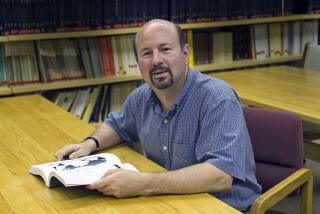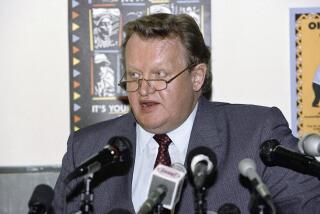Kenneth Wilson dies at 77; physicist won Nobel Prize
Physicist Kenneth G. Wilson, who earned a Nobel Prize for breakthrough research that explained how factors like temperature and pressure lead to sudden transformations of matter, such as boiling water’s shift from liquid to vapor, died Saturday in Saco, Maine. He was 77.
The cause was complications of lymphoma, according to Cornell University in Ithaca, N.Y., where he worked when he won the Nobel Prize in physics in 1982.
The prestigious award recognized Wilson for his sophisticated approach to answering such elemental riddles as why water boils or freezes and why magnets lose their power. Although these problems seem simple, the solutions had eluded scientists who attempted to explain the phenomena mathematically.
FOR THE RECORD:
Kenneth Wilson: A news obituary of Nobel Prize-winning physicist Kenneth G. Wilson in the June 21 LATExtra section said his survivors included a stepsister and two stepbrothers. They should have been identified as a half-sister and two half-brothers.
Wilson, who as a child could calculate the cube roots of numbers in his head, reduced the complexity of the problems by using a mathematical tool called the renormalization group, which broke down the problems into more manageable parts. His methodology led him to a powerful overall theory for understanding the critical points at which matter changes from one state to another.
PHOTOS: Notable deaths of 2013
The Royal Swedish Academy of Sciences, which awards the Nobel, called Wilson’s approach “ingenious.”
“Instead of a frontal attack,” the academy said in announcing the award, “he developed a method to divide the problem into a sequence of simpler problems in which each part could be solved.”
Scientists said Wilson’s theory explaining “phase transitions” such as liquid to gas had broad potential, capable of predicting the behavior of many types of matter, from quarks to the molecular underpinnings of hurricanes.
“Ken Wilson was one of a very small number of physicists who changed the way we all think, not just about specific phenomena, but about a vast range of different phenomena,” Steven Weinberg, a physics Nobel laureate at the University of Texas, said in a statement released by Cornell.
Wilson published his seminal work in two papers, in 1971 and 1972, the latter of which was co-written with a Cornell colleague, Michael Fisher. Fisher and Leo Kadanoff of the University of Chicago were among several physicists who contributed background work to the development of Wilson’s theory, but the Swedish academy gave the award to Wilson because, it said, his approach solved the problem “in a definite and profound way.”
Kenneth Geddes Wilson was born in Waltham, Mass., on June 8, 1936. He was the oldest of six children of Edgar Bright Wilson Jr., a Harvard University chemist, and Emily Fisher, who did graduate work in physics before her marriage.
At 16, Wilson entered Harvard, where he majored in math while also studying physics and running varsity track. He graduated from Harvard in 1956 and earned a doctorate from Caltech in 1961.
At Caltech he studied under Murray Gell-Mann, the Nobelist renowned for his work in elementary particle physics. Gell-Mann and colleague Francis E. Low had developed the renormalization group method in the 1950s to solve a different problem from the one later tackled by Wilson, who ultimately unlocked the potential of their idea.
In 1963 Wilson joined Cornell, in part, because it “was reputed to have a good folk dancing group” that would allow him to indulge the hobby he had taken up in grad school, he wrote in his autobiographical essay for the Nobel Prize. He also was an avid hiker and kayaker.
In the early 1980s, he joined with a group of prominent scientists to lobby for government funding of supercomputer centers. In 1985 the National Science Foundation agreed to a $200-million, five-year program to establish the centers on four college campuses, including UC San Diego and Cornell, where Wilson was the director.
PHOTOS: Notable deaths of 2013
After 25 years at Cornell, he joined the faculty of Ohio State University in 1988, where he founded the Physics Education Research Group. In his last years before retiring in 2008, he focused on efforts to improve science and math education.
“He was very patient and willing to explain things to people,” said his wife, Alison Brown, a computing expert. “He had a good way of wanting to explain what he was doing because he always loved what he was doing.”
Wilson, who lived in Gray, Maine, is survived by his wife, stepmother, a brother, a sister, a stepsister and two stepbrothers.
More to Read
Start your day right
Sign up for Essential California for the L.A. Times biggest news, features and recommendations in your inbox six days a week.
You may occasionally receive promotional content from the Los Angeles Times.






